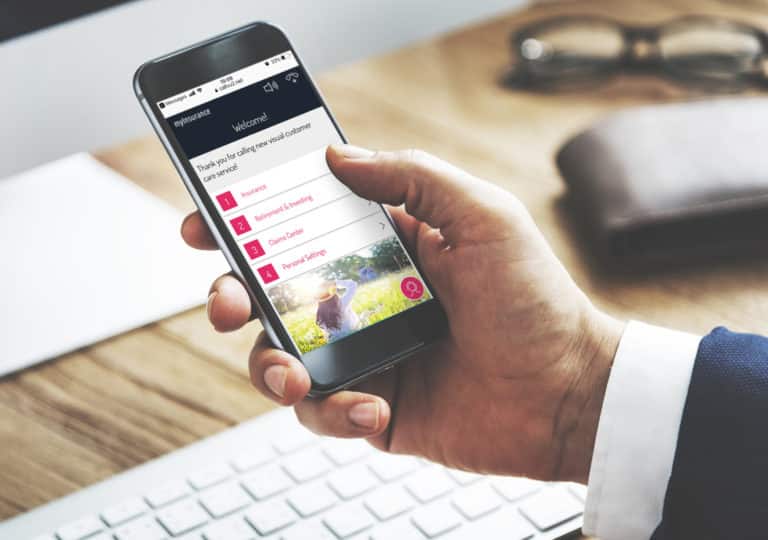Many companies are adding visual IVR to their customer service experience options. This post will outline the basics, and outline how visual IVR is a valuable tool to help customers get the answers they need more quickly, all while helping companies control costs.
Visual IVR brings VISUAL digital self-service into your IVR experience. It is a technology that allows customers to easily switch from IVR/Voice to a visual digital experience where they can self-serve to resolve their needs. Visual IVR provides a new approach to the long-running problem of customer frustration with traditional audio IVR systems.
Visual IVR relies on “app-like experiences” instead of other ways of “diverting,” “deflecting,” or “containing” calls in IVR, like with a bot or virtual assistant. With visual IVR, customers can use their phone’s touchscreen to navigate menu options. For example, a customer might use Visual IVR to log in or verify identity and fill out forms. Visual IVR apps can simply function as data collectors, or dynamically deliver information based on customer inputs made within the app experience. It helps improve call diversion/call deflection rates significantly.
A Typical Journey
A visual IVR solution journey begins when the customer calls the customer support number. In the series of options they hear as part of the traditional IVR menus, they are given the opportunity to receive a link to a self-service application to help them get answers and resolution to their issue more quickly and easily. If they choose this path from the IVR menu, they receive a short link via SMS text message on their smartphone.
Clicking the link on their mobile device redirects them to a secure web app where they can see and interact with visual data, menus, and forms. Since people are generally more adept at processing visually-delivered information, they usually have a much easier time getting what they need than via audio-only options.
When the user makes the channel switch to digital, the traditional IVR/voice call can either disconnect or can continue to guide the user through the digital workflow with audio prompts that are coordinated with the digital workflow to help guide the user to a successful resolution.
Faster, Simpler Alternatives to Live Agent Support
Visual IVR systems are becoming increasingly popular to offer a more user-friendly experience than traditional audio-only IVR systems. Studies have shown that visual IVR systems can increase customer satisfaction and reduce the time-to-resolution – how long it takes for their need or problem to be resolved.
How Many Calls Can Be Diverted with Visual IVR
If your contact center is like most, it is inundated with calls for straightforward questions and needs – questions that do not need to be answered by agents. For example, lots of companies find that many callers simply want their account balance or payment details. These unnecessary calls cost a fortune – the average cost per minute from live agent support is $1 a minute!
By incorporating visual IVR, you can divert some or all of these calls to simple forms. Using these graphical interfaces, the user can provide the necessary information and get the answer they want far faster than waiting for an agent.
FICX works with many companies that deploy visual IVR to help divert straightforward customer queries to digital self-service experiences. On average, about 30% of calls can be diverted in the first year of deployment. This figure rises to 80-90% by the end of year two as more customers become familiar with the experience. Over time, we are seeing adoption rates rise more quickly. This is because consumers that have used visual IVR in their interactions with other businesses adopt new experiences more readily.
Depending on the size of your call volumes, it is not unheard of to save millions of dollars annually – some save tens of millions! What’s more, because the customers get answers more quickly and easily, customer satisfaction scores rise as your support costs fall.
Practical Use Cases for Visual IVR
Here are some examples of self-service processes that are great candidates for deployment over visual IVR to drive self-service adoption and lower overall support costs:
- Update Info on File: This is a classic example of a task that does not require the involvement of an agent. In addition to avoiding the wait time for speaking with a company employee, it is likely faster and easier for the customer to input the updated information themself versus having to communicate it via speech for agent transcription.
- Balance and Payment Info: Even if your existing audio-only IVR system has a process for addressing these questions, providing visual options via SMS link could drive higher call diversion rates and improved satisfaction among those who prefer visual experiences.
- Make a Payment: Few audio IVRs tackle this use case well; it is challenging for many customers to complete all the necessary steps in an audio-only environment. With visual IVR, it is incredibly straightforward.
- Vacation Notices: Many banks encourage customers to notify them of upcoming travel plans to help add additional security for credit cards, debit cards, and other accounts. Again, accomplishing this task would be easier for most people if they had a visual interface through which to do so.
- Insurance First Notice of Loss: When customers make a claim, much of the requested information is at least as easily delivered via a visual interface as over the phone with an agent. Further, many customers prefer to perform the maximum number of tasks via self-service. Finally, asking customers to complete this task by themselves eliminates the “dead time” that agents experience while customers look for account numbers and other information.
- Apply Online: Many customers could quickly onboard for products and services with a visual IVR digital self-service option. While live rep interactions better serve some sales processes, others are so straightforward that a DIY approach could help boost completion rates, conversion counts, and revenue.
- Service Changes: Customers could easily adjust the level of service (e.g., monthly minutes for a cellular plan) by reviewing a visual comparison and making a selection in a visual IVR form.
The list of potential use cases is virtually endless. It’s easy to identify dozens of use cases in Banking, Lending, Healthcare, Telecom, Insurance, and a host of other industries.
Visual Versus Conversational IVR
Some companies have deployed conversational IVR, where customers can ask questions and provide voice inputs when they call versus following dial-tone-based menus. With conversational IVR, AI and natural language processing (NLP) systems parse the customer’s question and try to identify the correct answer without involving an agent. A key benefit of conversational IVR is allowing the user to jump directly to their desired action versus getting lost in long or complex IVR menus. With any bot or NLP solution, the key challenge is ensuring your solution can process the full range of customer queries.
Nevertheless, in our experience, visual apps play a slightly different or broader role in helping drive higher completion rates and call diversion. While conversational IVR systems are great for navigating large IVR trees, it can be difficult to resolve many needs with audio alone. Most people find it easier to consume and input information visually. For example, reading a credit card number aloud creates security concerns, and capturing an email can be very difficult when the exact spelling is difficult to determine from audio alone.
We have seen a number of companies integrate both digital self-service and conversational IVR to streamline navigation and resolution of customer needs. In these installations, the conversational IVR system quickly identifies the customer’s need. If it can resolve quickly over voice, it will. If not, it delivers a link to the appropriate self-service app to complete resolution.
Discover More
Visual IVR gives customers faster and easier access to the information they want while diverting unnecessary calls away from live agent support. You can improve customer outcomes and CSAT while dramatically lowering the costs of providing live customer support. Further, fewer calls mean you need fewer live agents to support customers – something that many companies want as they face the challenges of the “Great Resignation” and increased difficulty hiring great support professionals.
For more information on visual IVR, you can visit our homepage, request a demo, or review some of the other posts we have developed – many of which are listed below.





